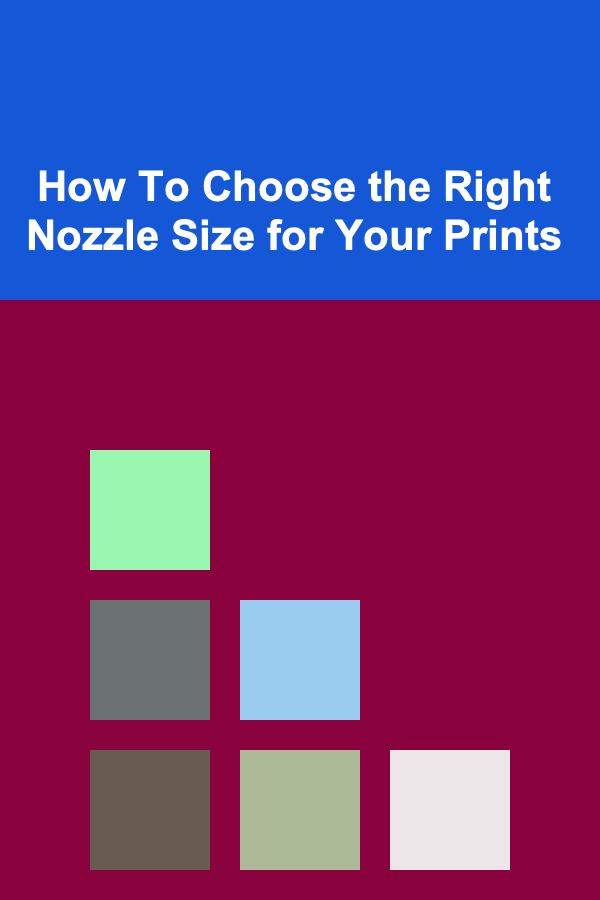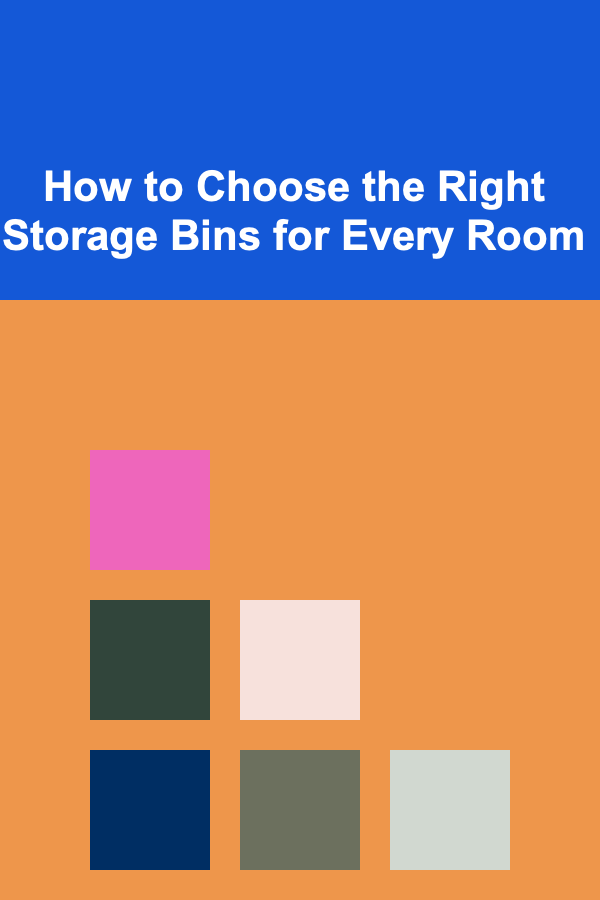
How To Choose the Right Nozzle Size for Your Prints
ebook include PDF & Audio bundle (Micro Guide)
$12.99$6.99
Limited Time Offer! Order within the next:

When it comes to 3D printing, one of the most crucial decisions you will make is choosing the right nozzle size for your prints. The nozzle is the part of your 3D printer that controls the flow of filament as it is extruded onto your print bed, and the size of the nozzle directly influences the speed, resolution, and strength of your print. Selecting the right nozzle size can help you achieve the desired level of detail and quality in your prints while also optimizing for print speed and material efficiency.
This article will guide you through the process of choosing the appropriate nozzle size for your specific 3D printing needs, taking into account factors such as material type, print resolution, and intended use of the final product.
Understanding Nozzle Sizes
The size of a 3D printer nozzle refers to the diameter of the opening through which the filament is extruded. Nozzle sizes typically range from 0.2mm to 1.0mm, with 0.4mm being the most common and default size for many 3D printers. However, the choice of nozzle size can greatly impact the final print quality and speed, and understanding how different sizes affect the printing process is key to making the right decision.
Common Nozzle Sizes and Their Applications:
- 0.2mm: Ideal for high-detail prints and small models. Often used for miniatures, jewelry, and intricate designs.
- 0.4mm: The standard and most commonly used nozzle size for general 3D printing. It provides a good balance between speed and resolution.
- 0.6mm: Suitable for larger prints or projects that don't require extreme detail. It allows for faster print speeds while still maintaining a reasonable resolution.
- 0.8mm and 1.0mm: Used for fast printing of large models. These larger nozzles sacrifice detail for quicker print times, making them ideal for prototypes or functional parts that do not require fine detail.
Choosing the right nozzle size depends on the specific requirements of your project. Understanding the relationship between nozzle size, layer height, and print resolution is critical in making an informed decision.
How Nozzle Size Affects Print Resolution
The resolution of a 3D print is determined by several factors, with nozzle size being one of the most influential. The smaller the nozzle, the finer the detail that can be achieved. However, there are trade-offs between resolution and speed.
Impact of Smaller Nozzles:
- Higher Resolution: Smaller nozzles (e.g., 0.2mm to 0.4mm) produce finer layers with greater precision, making them ideal for detailed objects like figurines, models, or prototypes that require intricate details.
- Longer Print Times: Smaller nozzles extrude less filament per layer, which means prints take longer to complete. This is something to consider if you're working with large or complex designs.
Impact of Larger Nozzles:
- Lower Resolution: Larger nozzles (e.g., 0.6mm or 1.0mm) result in thicker layers and less detail. These nozzles are not suitable for fine, intricate designs but are perfect for quick prototypes or functional parts.
- Faster Print Times: Larger nozzles extrude more filament per layer, significantly reducing print times. This is ideal for printing large objects where speed is more important than fine details.
When choosing a nozzle size for resolution, it is important to balance the need for detail with the time available for printing. Fine details are critical for small-scale objects, while speed becomes more important for large-scale models.
Material Considerations
The type of filament you are using also plays a role in determining the appropriate nozzle size. Some materials require larger nozzles to function optimally, while others work best with smaller nozzles.
Filament Type and Recommended Nozzle Sizes:
- PLA (Polylactic Acid): PLA is one of the most commonly used 3D printing materials, and it works well with standard nozzle sizes such as 0.4mm or 0.6mm. PLA has good flow properties, allowing it to work well even with smaller nozzles. For detailed prints, 0.2mm or 0.4mm nozzles are ideal, while 0.6mm or larger nozzles are suitable for faster, less detailed prints.
- ABS (Acrylonitrile Butadiene Styrene): ABS also works well with 0.4mm nozzles, but some users prefer slightly larger sizes (e.g., 0.6mm) to prevent issues with warping, especially for larger prints.
- PETG (Polyethylene Terephthalate Glycol): PETG is a popular material for functional parts. A 0.4mm or 0.6mm nozzle is generally recommended. Larger nozzles can help ensure consistent extrusion, especially for larger prints.
- Flexible Filaments (e.g., TPU): Flexible filaments can be tricky to work with because they are more prone to clogging in smaller nozzles. A 0.6mm or larger nozzle is often recommended for these materials.
- Nylon: Nylon filaments often benefit from slightly larger nozzles (e.g., 0.6mm or 0.8mm) to accommodate for their higher extrusion temperatures and tendency to produce stringing or clogging with smaller nozzles.
Temperature and Nozzle Size:
Higher extrusion temperatures are often required for more robust materials such as Nylon or polycarbonate. Larger nozzles are more forgiving in handling these materials, as they allow for a greater flow of material, reducing the risk of clogs. However, smaller nozzles work best with materials like PLA, which have lower extrusion temperatures.
Print Speed and Nozzle Size
Another crucial factor in choosing the right nozzle size is the balance between print speed and quality. Larger nozzles extrude more material per second, which allows for faster prints but with a trade-off in resolution. Smaller nozzles extrude less material and produce more detailed prints but require more time to complete the job.
Factors to Consider for Speed:
- Larger Nozzles for Faster Prints: If you're printing a large object or prototype that doesn't require extreme detail, larger nozzles (e.g., 0.6mm or 1.0mm) will speed up the print significantly.
- Smaller Nozzles for Detailed Prints: For prints that require fine details, such as miniatures or intricate designs, a smaller nozzle (e.g., 0.2mm or 0.4mm) is essential for achieving the highest resolution, even though it will slow down the print time.
The key to selecting the right nozzle size for speed is determining whether time or quality is more important for your project. For functional parts or prototypes, speed is often a priority. For decorative or high-detail prints, resolution and quality take precedence over speed.
Layer Height and Nozzle Size
Layer height refers to the thickness of each individual layer of filament that is extruded during the printing process. The layer height is typically chosen based on the nozzle size, and it plays a major role in determining the quality of your print.
Recommended Layer Heights Based on Nozzle Size:
- 0.2mm Nozzle: A typical layer height for a 0.2mm nozzle is between 0.1mm and 0.2mm, depending on the level of detail required. Smaller layer heights result in finer prints but take longer to complete.
- 0.4mm Nozzle: The standard layer height for a 0.4mm nozzle is usually between 0.2mm and 0.3mm. This provides a good balance of detail and print speed.
- 0.6mm Nozzle: Layer heights of 0.3mm to 0.4mm work well with 0.6mm nozzles, allowing for faster prints with a moderate level of detail.
- Larger Nozzles (0.8mm and 1.0mm): Larger nozzles often require layer heights of 0.4mm to 0.5mm, depending on the print speed and material. These nozzles are typically used for large prints where detail is less important.
When choosing a nozzle size, consider the thickness of the layers you need for your specific print. A smaller nozzle allows for finer layers and more detailed prints, while a larger nozzle enables thicker layers for faster prints.
Conclusion: Finding the Right Nozzle for Your Needs
Choosing the right nozzle size is a balancing act between several factors: print resolution, material compatibility, print speed, and layer height. To summarize:
- For detailed prints (e.g., miniatures, figurines, or intricate models), smaller nozzles (e.g., 0.2mm or 0.4mm) are the best choice.
- For functional parts or prototypes where speed is a priority, larger nozzles (e.g., 0.6mm or 1.0mm) will help you complete your prints faster, though they may sacrifice some resolution.
- Consider the material you're printing with and its extrusion requirements when choosing the nozzle size.
- Layer height should match the nozzle size to ensure the best results.
Ultimately, the right nozzle size depends on the specific needs of your project, so take the time to experiment with different sizes to find the one that works best for you. Whether you prioritize speed, quality, or strength, there is a nozzle size that will suit your needs and help you achieve optimal results in your 3D printing endeavors.

How to Choose the Right Storage Bins for Every Room
Read More
How to Offer Travel Consulting Services to Aspiring Travelers
Read More
How to Save on Home Renovation Costs While Sticking to a Budget
Read More
How to Sell Vintage Movie Posters on eBay: An Actionable Guide
Read More
How to Use Baskets for a Stylish Essential Oil Display
Read More
The Facilities Manager's Toolkit: Proven Techniques for Managing and Maintaining Facilities
Read MoreOther Products

How to Choose the Right Storage Bins for Every Room
Read More
How to Offer Travel Consulting Services to Aspiring Travelers
Read More
How to Save on Home Renovation Costs While Sticking to a Budget
Read More
How to Sell Vintage Movie Posters on eBay: An Actionable Guide
Read More
How to Use Baskets for a Stylish Essential Oil Display
Read More